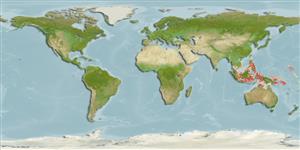Klassifizierung / Names
Namen | Synonyme | Catalog of Fishes(Gattung, Arten) | ITIS | CoL | WoRMS | Cloffa
>
Gobiiformes (Gobies) >
Gobiidae (Gobies) > Gobiinae
Etymology: Trimma: Greek, trimma, -atos = something crushed (Ref. 45335); agrena: Name from Greek "agrenon" meaning a net, referring to the mesh-like pattern on the body formed by the strongly outlined scale pockets; noun in apposition..
More on authors: Winterbottom & Chen.
Environment: milieu / climate zone / depth range / distribution range
Ökologie
seewasser riff-verbunden; tiefenbereich 2 - 20 m (Ref. 90102). Tropical
Western Pacific: Malaysia, the Philippines and Indonesia.
Size / Gewicht / Alter
Maturity: Lm ? range ? - ? cm
Max length : 2.1 cm SL (female)
Rückenflossenstacheln (insgesamt): 6 - 7; Rückenflossenweichstrahlen (insgesamt): 8-10; Afterflossenstacheln 1; Afterflossenweichstrahlen: 8 - 9. Distinguished by the combination of the following features: no predorsal scales anterior extension of body scales along the side of the nape from half-way between the eye and the shoulder spot in juveniles to just behind the eye in adults; body light brown with orange spots or stripes on the head, a dark greyish orange shoulder spot above pectoral fin base, and scale pockets strongly outlined with dark brown chromatophores with an orange spot at the junction between adjacent pockets in the same longitudinal row (Ref. 51083).
Inhabits reef crevices and caves in 2-20 m (Ref. 90102).
Life cycle and mating behavior
Geschlechtsreife | Fortpflanzung | Ablaichen | Eier | Fecundity | Larven
Winterbottom, R. and I.-S. Chen, 2004. Two new species of Trimma (Teleostei: Gobiidae) from the western Pacific Ocean. Raffles Bull. Zool. 11(Sup.):103-106. (Ref. 51083)
IUCN Rote Liste Status (Ref. 130435)
Bedrohung für Menschen
Harmless
Nutzung durch Menschen
Mehr Information
NamenSynonymeMetabolismusRäuberÖkotoxikologieFortpflanzungGeschlechtsreifeAblaichenSpawning aggregationFecundityEierEientwicklung
ReferenzenAquakulturAquakultur ProfilZuchtlinienGenetikElectrophoresesVererbbarkeitKrankheitenVerarbeitungNutrientsMass conversion
PartnerBilderStamps, Coins Misc.LauteCiguateraGeschwindigkeitSchwimmstilKiemenoberflächeOtolithsGehirngrößeSehfähigkeit
Tools
Zusatzinformationen
Download XML
Internet Quellen
Estimates based on models
Preferred temperature (Ref.
123201): 28.4 - 29.3, mean 28.8 °C (based on 732 cells).
Phylogenetic diversity index (Ref.
82804): PD
50 = 0.5000 [Uniqueness, from 0.5 = low to 2.0 = high].
Bayesian length-weight: a=0.01023 (0.00477 - 0.02194), b=3.02 (2.84 - 3.20), in cm total length, based on LWR estimates for this (Sub)family-body shape (Ref.
93245).
Widerstandsfähigkeit (Ref.
120179): hoch, Verdopplung der Population dauert weniger als 15 Monate. (Preliminary K or Fecundity.).
Fishing Vulnerability (Ref.
59153): Low vulnerability (10 of 100).
Nutrients (Ref.
124155): Calcium = 416 [178, 1,466] mg/100g; Iron = 1.91 [0.79, 4.31] mg/100g; Protein = 18 [16, 20] %; Omega3 = 0.162 [0.049, 0.523] g/100g; Selenium = 31.5 [9.0, 93.9] μg/100g; VitaminA = 114 [21, 603] μg/100g; Zinc = 5.11 [2.68, 8.76] mg/100g (wet weight);
